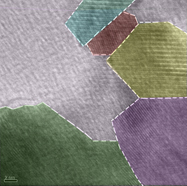Crossref Citations
This article has been cited by the following publications. This list is generated based on data provided by Crossref.
Lee, Dong
and
Kaiser, Alan
2012.
Graphite, Graphene, and Their Polymer Nanocomposites.
p.
95.
Li, Z.
Zhao, G. L.
Zhang, P.
Guo, S.
and
Tang, J.
2012.
Thermoelectric Performance of Micro/Nano-Structured Bismuth-Antimony-Telluride Bulk from Low Cost Mechanical Alloying.
Materials Sciences and Applications,
Vol. 03,
Issue. 12,
p.
833.
Liu, Chia-Jyi
Liu, Gao-Jhih
and
Su, Chi-Jung
2012.
Power factor improvement in hydrothermally synthesized Bi2−xSbxTe3 (x=1.5) — carbon sphere composites.
Journal of Solid State Chemistry,
Vol. 193,
Issue. ,
p.
127.
Liu, Chia-Jyi
Lai, Hsin -Chang
Liu, Yen-Liang
and
Chen, Liang-Ru
2012.
High thermoelectric figure-of-merit in p-type nanostructured (Bi,Sb)2Te3 fabricated via hydrothermal synthesis and evacuated-and-encapsulated sintering.
Journal of Materials Chemistry,
Vol. 22,
Issue. 11,
p.
4825.
Grasso, Salvatore
Tsujii, Naohito
Jiang, Qinghui
Khaliq, Jibran
Maruyama, Satofumi
Miranda, Miriam
Simpson, Kevin
Mori, Takao
and
Reece, Michael J.
2013.
Ultra low thermal conductivity of disordered layered p-type bismuth telluride.
Journal of Materials Chemistry C,
Vol. 1,
Issue. 12,
p.
2362.
Liu, Chia-Jyi
Liu, Yen-Liang
Lai, Hsin-Chang
Chen, Liang-Ru
and
Zou, Yi-Yan
2013.
Effects of Reaction Temperature on Thermoelectric Properties of p-Type Nanostructured Bi2−x Sb x Te3 Prepared Using Hydrothermal Method and Evacuated-and-Encapsulated Sintering.
Journal of Electronic Materials,
Vol. 42,
Issue. 7,
p.
1550.
Finefrock, Scott W.
Yang, Haoran
Fang, Haiyu
and
Wu, Yue
2015.
Thermoelectric Properties of Solution Synthesized Nanostructured Materials.
Annual Review of Chemical and Biomolecular Engineering,
Vol. 6,
Issue. 1,
p.
247.
Cui, S.
Boussard-plédel, C.
Calvez, L.
Rojas, F.
Chen, K.
Ning, H.
Reece, M. J.
Guizouarn, T.
and
Bureau, B.
2015.
Comprehensive study of tellurium based glass ceramics for thermoelectric application.
Advances in Applied Ceramics,
Vol. 114,
Issue. sup1,
p.
S42.
Lin, Fei-Hung
and
Liu, Chia-Jyi
2016.
One-pot room-temperature aqueous synthesis of Ag2Te–Ag nanocomposites.
Green Chemistry,
Vol. 18,
Issue. 19,
p.
5288.
Lin, Fei-Hung
Pai, Yi-Hsuan
Chu, Yu-Hsien
and
Liu, Chia-Jyi
2017.
Synthesis and Electronic Transport of n-Type Ag2Te1−x Se x (x = 0, 0.01, and 0.02) via Aqueous Solution Method at Room Temperature.
Journal of Electronic Materials,
Vol. 46,
Issue. 5,
p.
3025.
Chen, Wei-Hao
Yang, Zong-Ren
Lin, Fei-Hung
and
Liu, Chia-Jyi
2017.
Nanostructured SnSe: hydrothermal synthesis and disorder-induced enhancement of thermoelectric properties at medium temperatures.
Journal of Materials Science,
Vol. 52,
Issue. 16,
p.
9728.
Yang, Zong-Ren
Chen, Wei-Hao
and
Liu, Chia-Jyi
2017.
Synthesis and Electronic Transport of Hydrothermally Synthesized p-Type Na-Doped SnSe.
Journal of Electronic Materials,
Vol. 46,
Issue. 5,
p.
2964.
Dharmaiah, Peyala
and
Hong, Soon‐Jik
2018.
Hydrothermal method for the synthesis of Sb2Te3, and Bi0.5Sb1.5Te3 nanoplates and their thermoelectric properties.
International Journal of Applied Ceramic Technology,
Vol. 15,
Issue. 1,
p.
132.
Liu, En-Yu
Lin, Fei-Hung
Yang, Zong-Ren
and
Liu, Chia-Jyi
2018.
A facile energy-saving route of fabricating thermoelectric Sb
2
Te
3
-Te nanocomposites and nanosized Te
.
Royal Society Open Science,
Vol. 5,
Issue. 10,
p.
180698.
Lim, Jun Young
Cho, Sangwon
Kim, Hoyeon
and
Seo, Yongsok
2019.
Optimum Thermoelectric Performance of Bismuth–Antimony–Telluride Alloy/PEDOT:PSS Nanocomposites Prepared by an Innovative Redox Process.
ACS Applied Energy Materials,
Vol. 2,
Issue. 11,
p.
8219.
Lin, Fei-Hung
and
Liu, Chia-Jyi
2019.
A simple energy-saving aqueous synthesis of Bi2Te3 nanocomposites yielding relatively high thermoelectric power factors.
Ceramics International,
Vol. 45,
Issue. 7,
p.
9397.
Nandihalli, Nagaraj
Pai, Yi-Hsuan
and
Liu, Chia-Jyi
2020.
Fabrication and thermoelectric properties of Pb (Zn0.85Al0.15) Te-Te (y = 0, 0.04, 0.06, 0.08, and 0.11) nanocomposites.
Ceramics International,
Vol. 46,
Issue. 5,
p.
6443.
Yang, Zong-Ren
and
Liu, Chia-Jyi
2020.
Thermoelectric Transport in p-Type (Pb0.98Na0.02Te)1−x(Zn0.85Al0.15Te)x-Te Composites Fabricated Using a Combination of Hydrothermal Synthesis and Evacuating-and-Encapsulating Sintering.
Journal of Electronic Materials,
Vol. 49,
Issue. 5,
p.
2954.
Sudarshan, C.
Jayakumar, S.
Vaideki, K.
and
Sudakar, C.
2020.
Te-rich Bi2Te3 thin films by electron−beam deposition: Structural, electrical, optical and thermoelectric properties.
Thin Solid Films,
Vol. 713,
Issue. ,
p.
138355.
Liu, Chia-Jyi
2021.
Handbook of Greener Synthesis of Nanomaterials and Compounds.
p.
521.





